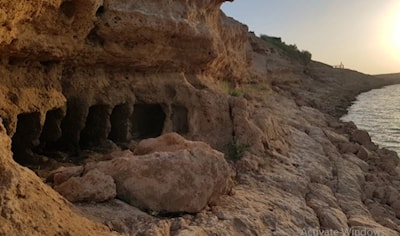Iraq: Receding Euphrates levels unravel underwater ancient areas
The drop in water levels of the Euphrates river has led to the discovery of 80 ancient areas in western Iraq.
-

Iraq: Lowering the Euphrates water level reveals underwater ancient areas
After the Euphrates River's water level dropped, the city of Anah in Anbar province, located in western Iraq, saw the emergence of historical and ancient sites, including the jails and cemetery of the city of "Talbes", which dates back before Christ.
There are hundreds of historical cities and localities in Iraq, as well as a vast number of ancient areas under water or soil that have yet to be uncovered.
Ancient places
Mohammed Jassim, the person in charge of the reconstruction of Anah city's ancient minaret in Anbar, stated, "The appearance of ancient places at this time of year is due to the decrease in the water level of the Haditha Dam lake due to Turkey's decrease in the release of water from the Euphrates River."
Mohammad Jassim said, “The decrease in the water level in the Euphrates catchment area, like before the construction of the Haditha Dam, has led to the emergence of at least 80 ancient and historical sites from underwater.”
Read next: Drought reveals ruins of 3,400-year-old lost city in Iraq
He said, “Talbes prison” is actually a collection of graves belonging to the Assyrian period, which this empire conquered.
Jassim stressed that "the appearance of these ancient sites is temporary and as a result of the water level of Haditha Dam decreasing, so we cannot be sure that the water will continue to decrease until excavation and archeology activities are carried out. Before draining Haditha Dam, an Italian archaeological team have excavations in this area. Some small rooms have been carved in the heart of the rocks, which are most likely the tombs of important people of that period.”
Lowering water levels, revealing the Telbas prison
The ancient city of Anah, located 350 kilometers west of Baghdad on the banks of the Euphrates River, is considered one of the oldest cities in the world, with a lifespan of more than 4 thousand years, and is mentioned in Babylonian and Assyrian writings, as well as historians such as Ammianus Marcellinus.
Read next: Iraq asks Turkey to allow more water through the Tigris and Euphrates
Hassan Al-Jama’ah, professor of history, says in this regard, “The residents of Anah sent a delegation to meet Ahmed Hassan Al-Bakr, the President of Iraq at the time, and asked the government officials to delay the construction of the dam so as not to have a negative impact on this ancient city. Devat insisted on its construction and believed that the positive points of building the dam are more than its negative points, so he did not pay attention to the flooding of this ancient area.”
He said, “This city submerged in water contains many historical buildings and monuments, even Sumerian and Babylonian peoples lived there, and Roman works were also visible before sinking.”
The ancient city of Telbas
Yahi Abdul Majeed” the director of the Archaeological Department of Anah city, stated that the catchment area of the Haditha Dam hosts more than 80 ancient sites, which are often submerged.
Abdul Majeed said, “The decrease in the water level in Anah city is one of the old natural phenomena so that the river water decreases in the summer season and the ancient places rise above the water, then it goes underwater again in other months of the year, especially in winter.”
He added, “These ancient places can be used to attract tourists during the summer season. There are cuneiform manuscripts in the rocks of Telbas region which is home to Babylonian, Assyrian, Roman, Sassanid and Islamic civilizations.”

 4 Min Read
4 Min Read









